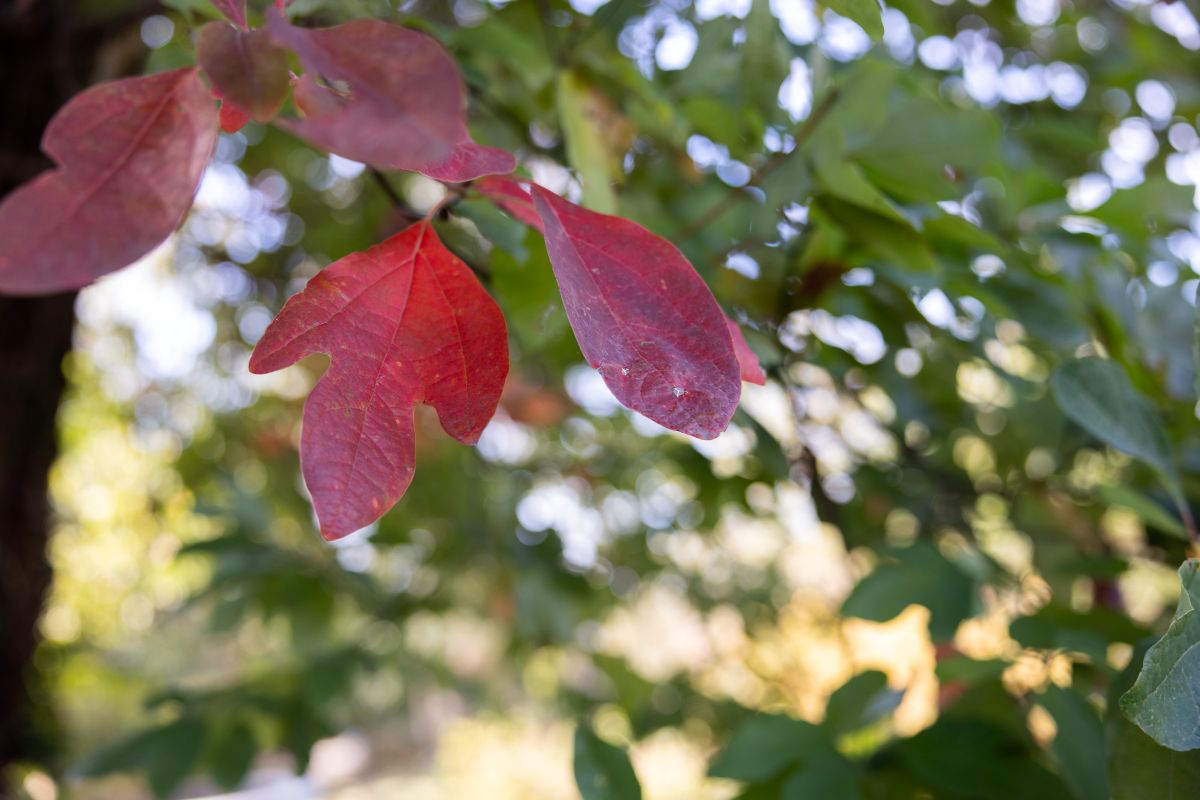
UT Gardens’ November Plant of the Month
Submitted by Lauren Carver, Photography and Events Coordinator, UT Gardens, Knoxville
Although maples may come to mind as the spectacle of resplendent fall color, Sassafras albidum can hold its own. One of the few trees with matching scientific and common names, Sassafras is sure to delight with its unique quirks.
Sassafras can be found in woodlands, groves or along roads and fences in a wide native range. Spanning from Maine to Texas, Sassafras is renowned for its unique foliage and piquant roots. This is a deciduous, flowering tree with a rich history of cultural significance. All parts of the tree are aromatic, and both the foliage and roots have been used in creating beverages, soaps, Filè powder and fragrances. Ecologically, Sassafras also supports Imperial Moths, Spicebush Swallowtails, various species of birds and small mammals. It is also resistant to deer, drought, heat and Black Walnut (Juglans nigra).
Sporting entire, mitten-shaped and three-lobed leaves on every tree – sometimes even on the same branch – this native wonder boasts a spectacular presentation in autumn with rich hues of yellow, orange and red. While underused in residential landscapes, this tree has the potential to offer year-round seasonal appeal. With deeply furrowed, crisscross patterned bark visible in winter, leading to delicate, chartreuse flowers in spring, and colorful clusters of fruit (drupes) in summer and fall. Sassafras boasts a unique growth pattern, reaching heights of 30-60 feet and a spread of 25-40 feet. Its form can vary from pyramidal to irregular, showcasing a distinctive contorted branching pattern.
Sassafras prefers well-drained, sandy, acidic soil but will adapt to other soil types if well-drained. This species naturally forms a colony and can be allowed to grow into a thicket or cultivated into a specimen depending on your garden area and personal preference. As a specimen planting, root suckers can be removed periodically to promote growth in the desired shape and avoid unwanted thickets. It can alternatively be pruned and kept at shrub size by cutting down to the ground every two to three years. Consider using Sassafras in naturalized areas, woodland borders, privacy screens, for shade or as a specimen tree. You can find Sassafras in the Native American Interpretive Garden in Knoxville.
First detected in 2019 and spreading to 23 counties, Laurel Wilt has become an issue for Sassafras in the Southeast. The fungus Harringtonia lauricola that causes wilt is vectored primarily by redbay ambrosia beetles. Symptoms are similar to those of drought. However, early fall color on the leaves coupled with premature leaf drop are common as well as discoloration of the outer sapwood. This disease cannot be managed once the tree has been infected, often dying within weeks of contracting the fungus. Preventative treatment is available, though costly and often unpractical on a large scale.
The UT Gardens includes plant collections located in Knoxville, Crossville and Jackson, Tennessee. Designated as the official botanical garden for the State of Tennessee, the UT Gardens are part of the UT Institute of Agriculture. The Gardens’ mission is to foster appreciation, education and stewardship of plants through garden displays, educational programs and research trials. The Gardens are open during all seasons and free to the public.